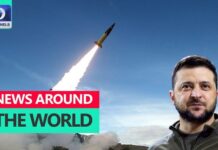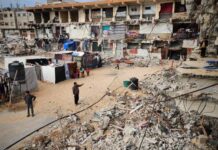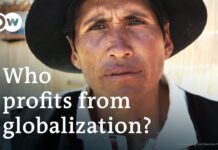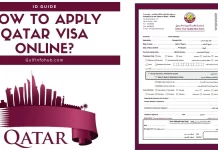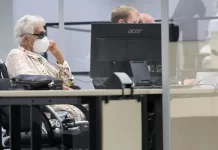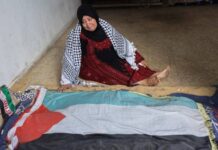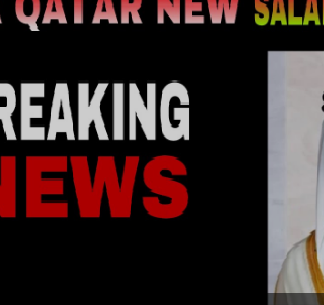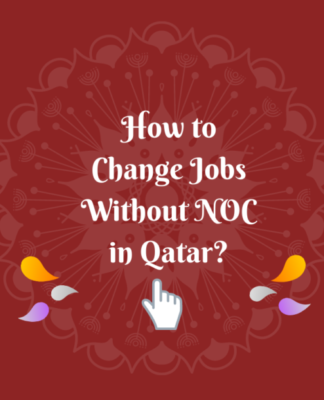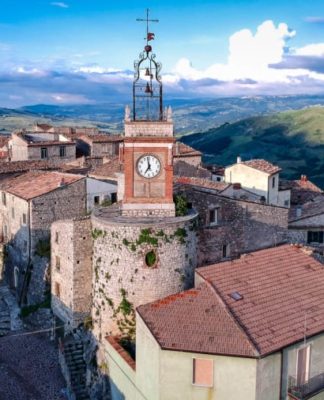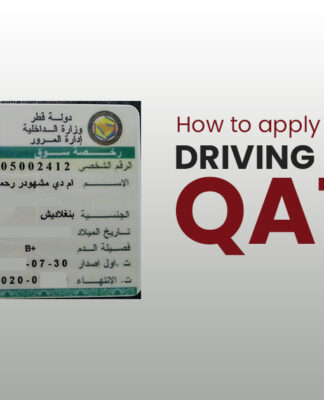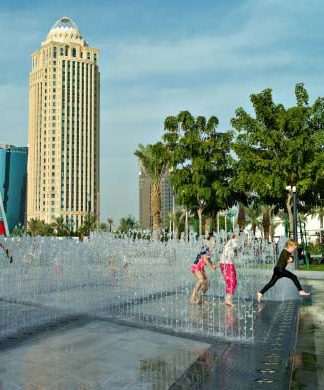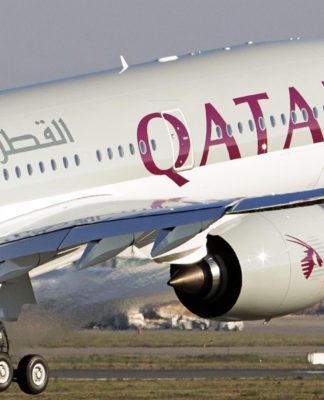In March, the Syrian conflict will enter its 8th year.
Meanwhile, more than 465,000 Syrians have been killed in the fighting, over a million injured, and over 12 million – half the country’s prewar population – have been displaced from their homes.
Here is the story of the conflict in Syria, explained from the beginning:
What caused the uprising?
While lack of freedoms and economic woes fuelled resentment of the Syrian government, the harsh crackdown on protesters inflamed public anger.
- Arab Spring: In 2011, successful uprisings – that became known as the Arab Spring – toppled Tunisia‘s and Egypt‘s presidents. This gave hope to Syrian pro-democracy activists.
- That March, peaceful protests erupted in Syria as well, after 15 boys were detained and tortured for writing graffiti in support of the Arab Spring. One of the boys, a 13-year-old, was killed after having been brutally tortured.
- The Syrian government, led by President Bashar al-Assad, responded to the protests by killing hundreds of demonstrators and imprisoning many more.
- Free Syrian Army: In July 2011, defectors from the military announced the formation of the Free Syrian Army, a rebel group aiming to overthrow the government, and Syria began to slide into civil war.
- While the protests in 2011 were mostly non-sectarian, the armed conflict surfaced starker sectarian divisions. Most Syrians are Sunni Muslims, but Syria’s security establishment has long been dominated by members of the Alawi sect, of which al-Assad is a member.
- In 1982, Bashar’s father ordered a military crackdown on the Muslim Brotherhood in Hama, killing tens of thousands of people and flattening much of the city.
- Even global warming is said to have played a role in sparking the 2011 uprising. Severe drought plagued Syria from 2007-10, causing as many as 1.5 million people to migrate from the countryside into cities, exacerbating poverty and social unrest.
|
|
International involvement
Foreign backing and open intervention have played a large role in Syria’s civil war. Russia entered the conflict in 2015 and has been the Assad government’s main ally since then.
- Regional actors: The governments of majority-Shia Iran and Iraq, and Lebanon-based Hezbollah, have supported al-Assad, while Sunni-majority countries, including Turkey, Qatar, and Saudi Arabia supported anti-Assad rebels.
- Since 2016, Turkish troops have launched several operations against the Islamic State of Iraq and the Levant (ISIL, also known as ISIS) near its borders, as well as against Kurdish groups armed by the United States.
- Anti-ISIL coalition: The US has armed anti-Assad rebel groups and led an international coalition bombing ISIL targets since 2014.
- Israel carried out air raids inside Syria, reportedly targeting Hezbollah and pro-government fighters and facilities. The first time Syrian air defenses shot down an Israeli war plane was in February 2018.
|
|
US and Russia
The US has repeatedly stated its opposition to the Assad government backed by Russia but has not involved itself as deeply.
- Chemical red line: Former US President Barack Obama had warned that the use of chemical weapons in Syria was a “red line” that would prompt military intervention.
- In April 2017, the US carried its first direct military action against Assad’s forces, launching 59 Tomahawk cruise missiles at a Syrian air force base from which US officials believe a chemical attack on Khan Sheikhoun had been launched.
- CIA training: In 2013, the CIA began a covert programme to arm, fund and train rebel groups opposing al-Assad, but the programme was later shut down after it was revealed that the CIA had spent $500m but only trained 60 fighters.
- Russia’s campaign: In September 2015, Russia launched a bombing campaign against what it referred to as “terrorist groups” in Syria, which included ISIL as well as anti-Assad rebel groups backed by the USA. Russia has also deployed military advisers to shore up Assad’s defences.
- At the UN Security Council, Russia and China have repeatedly vetoed Western-backed resolutions on Syria.
|
|
Peace talks
Peace negotiations have been ongoing between the Syrian government and the opposition in order to achieve a military ceasefire and political transition in Syria, but the main sticking point has been the fate of al-Assad.
- Geneva: The first round of UN-facilitated talks between the Syrian government and opposition delegates took place in Geneva, Switzerland in June 2012.
- The latest round of talks in December 2017 failed amid a tit-for-tat between Syrian government and opposition delegates over statements about the future role of al-Assad in a transitional government.
- In 2014 Staffan de Mistura replaced Kofi Annan as the UN special envoy for Syria.
- Astana: In May 2017, Russia, Iran and Turkey called for the setup of four de-escalation zones in Syria, over which Syrian and Russian fighter jets were not expected to fly.
- Sochi: In January 2018, Russia sponsored talks over the future of Syria in the Black Sea city of Sochi, but the opposition bloc boycotted the conference, claiming it was an attempt to undercut the UN effort to broker a deal.
Rebel groups
Since the conflict began, as a Syrian rebellion against the Assad government, many new rebel groups have joined the fighting in Syria and have frequently fought one another.
- The Free Syrian Army (FSA) is a loose conglomeration of armed brigades formed in 2011 by defectors from the Syrian army and civilians backed by the United States, Turkey, and several Gulf countries.
- In December 2016, the Syrian army scored its biggest victory against the rebels when it recaptured the strategic city of Aleppo. Since then, the FSA has controlled limited areas in northwestern Syria. Since January 2018 it has been fighting with Turkey to capture Afrin from Kurdish fighters seeking self-rule.
- ISIL emerged in northern and eastern Syria in 2013 after overrunning large portions of Iraq. The group quickly gained international notoriety for its brutal executions and its energetic use of social media to recruit fighters from around the world.
- Other groups fighting in Syria include Jabhat Fateh al-Sham, Iran-backed Hezbollah, and the Syrian Democratic Forces (SDF) dominated by the Kurdish People’s Protection Units (YPG).
|
|
The situation today
Fighting in Syria continues on two main fronts:
- Eastern Ghouta: Syrian government forces backed by Russian warplanes have continued to hit the rebel enclave of Eastern Ghouta, resulting in hundreds of civilians deaths.
- Eastern Ghouta has been under siege since 2013 and is the last remaining rebel stronghold near the capital, Damascus.
- The US also accused the Syrian government of using chemical weapons.
- Afrin: Turkey and the Free Syrian Army (FSA) began in January 2018 a military operation against the YPG in northwestern Syria, near Afrin. Pro-government forces have also joined the fight.
- Also in northwestern Syria, Hay’et Tahrir al-Sham rebels claimed responsibility for shooting down a Russian warplane near Idlib on February 3.
Syria: Who controls what? https://t.co/wAP493a8Jupic.twitter.com/r1zZdpoZRt
— Al Jazeera News (@AJENews) February 22, 2018
Syrian refugees
Now having gone on longer than World War II, the war in Syria is causing profound effects beyond the country’s borders, with many Syrians having left their homes to seek safety elsewhere in Syria or beyond.
- As of February 2018, the UN refugee agency (UNHCR) had registered over 5.5 million refugees from Syria and estimated that there are over 6,5 million internally displaced persons (IDP) within Syria’s borders.
- Lebanon, Turkey, and Jordan are hosting most of the Syrian refugees, many of whom attempt to journey onwards to Europe in search of better conditions.
- The 1951 Geneva Convention Relating to the Status of Refugees describes a refugee as any person who, “owing to well-founded fear of being persecuted for reasons of race, religion, nationality, membership of a particular social group or political opinion, is outside the country of his nationality and is unable or, owing to such fear, is unwilling to avail himself of the protection of that country”.
- In 2017, about 66,000 refugees returned to Syria, according to reports. With much of Syria in ruins, and a population deeply traumatised by war, one thing is certain: rebuilding Syria after the war will be a lengthy, difficult process.
SOURCE: AL JAZEERA NEWS







